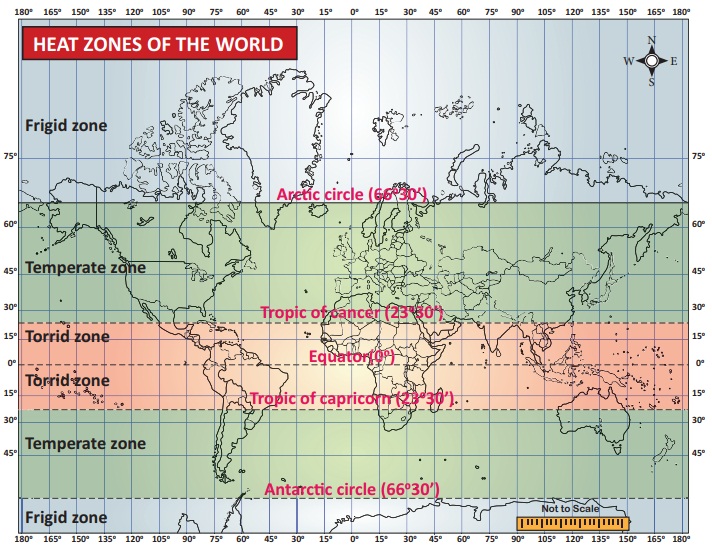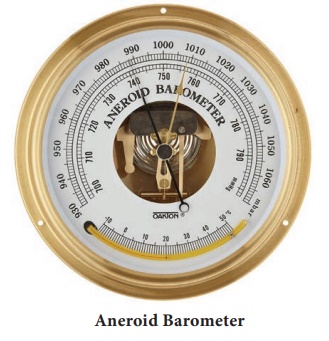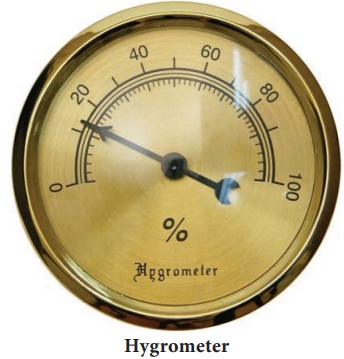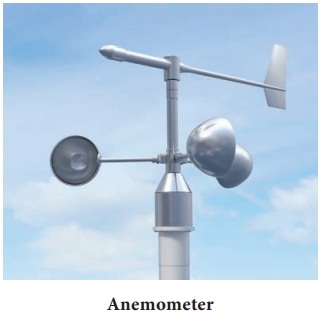Chapter 2 | Geography | 8th Social Science - Elements of weather and climate | 8th Social Science : Geography : Chapter 2 : Weather and Climate
Chapter: 8th Social Science : Geography : Chapter 2 : Weather and Climate
Elements of weather and climate
Elements of weather and climate
Temperature, rainfall, pressure, humidity and wind are the major elements of weather and climate.
1. Temperature

Temperature is one of the key elements of weather and climate. The earth and its atmosphere get heated from the sun through insolation. The degree of heat present in the air is termed as temperature. Apart from sun’s rays, the heat in air also depends the atmospheric mass to a small extent.
Distribution of weather elements are shown by means of Isolines on maps. Isolines are those which join the places of equal values. Isolines are given different names based on the weather element they represent.
Isotherm: Equal temperature
Isocryme: Equal lowest mean temperature for a specified period
Isohel: Equal sunshine
Isollobar: Equal pressure tendency showing similar changes over a given time
Isobar: Equal atmospheric pressure
Isohyet: Equal amount of rainfall
Temperature varies with time due to changes in the level of radiation which reach the earth surface. This is due to motions of the earth (The rotation and revolution) and inclination of the earth’s axis.
The temperature influences the level of humidity, the process of evaporation, condensation and precipitation.
Heat energy from solar radiation is received by the earth through three mechanisms. They are radiation, conduction and convection. The Earth's atmosphere is heated more by terriestrial radiation than insolation.
Temperature varies both horizontally and vertically. Temperature decreases with increasing height is known as Lapse rate which is 6.5 degree celsius per 1000 meters in troposphere .
b. Factors affecting the distribution of temperature
Latitude, altitude, nature of land, ocean currents, prevaling winds, slope, shelter and distance from the sea, natural vegetation and soil are the major factors which affect the distribution of temperature.
c. Measuring Temperature
The temperature of a unit volume of air at a given time is measured in scales like Celsius, Fahrenheit, and Kelvin. Meteorologist measures the temperature by the Thermometer, Stevenson screen and minimum and maximum Thermometer. The energy received by the earth through insolation is lost by outgoing radiation. Atmosphere is mainly heated by outgoing radiation from 2 to 4pm .So the maximum temperature is recorded between 2 and 4 pm regularly and minimum temperature is recorded around 4 am before sunrise.
Mean Temperature
The average of maximum and minimum temperatures within 24 hours is called mean daily temperature [(87oF+73oF)/2=80oF]. Diurnal range of temperature is the difference between the maximum and minimum temperatures of a day. Annual range of temperature is the difference between the highest and lowest mean monthly temperatures of a year. The distribution of temperature is shown by means of Isotherms. Isotherms are imaginary lines which connect the same temperatures of different places.
d. Heat zones of the earth
The fact that the earth is spherical in shape results in different parts of the earth getting heated differently.Based on the heat received from the sun, Earth is divided into three heat zones. They are
Torrid Zone
It is a region between the tropic of cancer and the tropic of Capricorn. This region receives the direct rays of the sun and gets the maximum heat from the sun.This zone known as the torrid or the tropical zone
Temperate zone
This zone lies between the Tropic of cancer and the Arctic circle in the Northern Hemisphere and between the Tropic of Capricorn and the Antartic circle in the southern Hemisphere.This zone gets the slanting rays of the sun and the angle of the sun’s rays goes on decreasing towards the poles.Thus this zone experiences moderate temperature.
Frigid Zone
The frigid zone lies between the Arctic circle and the North Pole and between the Antartic circle and the South Pole.This region also known as Polar region.Since it receives the extremely low temperature throughout the year,these regions are covered with snow.
Highest Temperature ever recorded
The highest temperature ever recorded on the earth is 56.7°C (134°F). It was recorded on 10th July 1913 at Greenland Ranch of Death Valley, California, USA.
Lowest Temperature ever recorded
The lowest temperature ever recorded on the earth is −89.2 °C (−128.6 °F; 184.0 K). It was recorded on 21st July, 1983 at Soviet Vostok Station in Antarctica.

2. Rainfall
Rain is a liquid water in the form of droplets that have condensed from atmospheric water vapour and then become heavy enough to fall under gravity. Rain is a major component of the water cycle and is responsible for depositing most of the fresh water on the Earth. It is the source of water for all purposes. There is a close relationship between the temperature and rainfall distribution. Generally rainfall is high in the equatorial region and decreases gradually towards poles. Rainfall is measured by Raingauge.

3. Air Pressure

The weight of air above a given area on the earth’s surface is called atmospheric pressure or air pressure. The air pressure is measured by Barometer. The standard air pressure at sea level is 1013.25mb. At the earth’s surface the pressure is 1.03kg.per sq cm. The variation in standard atmospheric pressure is found both horizontally and vertically. Based on the level of pressure, it is categorised into low pressure and high pressure. Low pressure area is an area in the atmosphere where the pressure is lower than its surrounding areas. In this situation, the wind from the surroundings blow towards the centre of low pressure. High pressure is an area of atmosphere where the barometric pressure is higher than its surrounding areas. In this case, the wind from the centre of high pressure blows towards the surrounding low pressure areas. Low pressure system is marked as “L” on weather map, where as the high pressure system is marked as “H”. Low pressure systems are also called as a depression and cyclones. High pressure system is called anti cyclones. Low pressure leads to cloudiness, wind, and precipitation. High pressure leads to fair and calm weather. Isobar is used to show the distribution of air pressure.
Highest pressure ever recorded.
The highest ever air pressure at sea level was recorded at Agata, Russia on 31st December, 1968. The pressure was1083.8mb
Lowest pressure ever recorded
The lowest pressure of 870mb was recorded at Typhoon Tip, near Guam, Mariana Island in Pacific Ocean on 12th October, 1979.
Humans are not sensitive to small variation in air pressure. But the small variations in pressure that do exist largely determine the wind and storm patterns of the earth. The distribution of atmospheric pressure is controlled by altitude, atmospheric temperature, air circulation, earth rotation, water vapour, atmospheric storms etc.
Measuring air pressure
Meteorologist uses barometer/aneroid barometer to measure the air pressure. Barograms are used for recording continuous variation in atmospheric pressure.
Why Do Your Ears Pop in Airplanes?
As you go up in an airplane, the atmospheric pressure becomes lower than the pressure of the air inside your ears. Your ears pop because they are trying to equalize or match the pressure. The same thing happens when the plane is on the way down and your ears have to adjust to a higher atmospheric pressure.
4. Humidity
Humidity refers to the degree of water vapour present in the atmosphere in gaseous form in particular time and place. It ranges from 0-5 percent by volume in atmosphere. Climatically it is an important constituent of the atmosphere and its quantity depends on the level of temperature. So, the level of humidity decreases towards poles from equator. Humidity is expressed in different ways.

Specific humidity is a ratio of the water vapor content of the mixture to the total air content on a mass basis. It is expressed in grams of vapour per kilogram of air.
Absolute Humidity is the mass or weight of water vapour present per unit volume of air. It is expressed usually in grams per cubic meter of air.
Relative humidity is a ratio between the actual amount of water vapour present in the air and the maximum amount of water vapour it can hold at a given temperature. It is expressed as a percentage.
Generally, warm air holds more water vapour than the cold air. When relative humidity reaches 100%, the air gets saturated. In this condition the temperature is said to be at dew-point. Further
cooling will condense the water vapour into the clouds and rain. Relative humidity affects human health and comfortness. Very high and very low humidity are injurious to health. It also affects the stability of different objects, buildings and electrical applications.
Measurement of Humidity
Hygrometer is used to measure the humidity. (which comprises wet and dry bulb-plate side by side in the Stevenson screen)
Find out
The effect of low and high humidity over Human beings in particular.
Answer: In low humid climate, the sweat will be earned away by the air. Since surrounding air is not that saturated. In high humid areas, the air will have enough water.vapours (saturated) and it can’t hold any more water vapour, so humans will feel sweat running across the body and feel uncomfortable.
With decreasing air pressure,the availability of oxygen to breath also decreases. At very high altitudes, atmospheric pressure and available oxygen get so low that people can become sick and even die. Mountain climbers use bottled oxygen when they ascend very high peaks. They also take time to get used to the altitude as the quick move from high pressure to low pressure can cause decompression sickness. Aircraft create artificial pressure in the cabin which makes the passengers remain comfortable while flying.
5. Wind
The horizontal movement of air is called wind. Vertical movement of air is said as air current. The winds move from high pressure to low pressure. Unlike other elements a wind is made up of a series of gusts and eddies which can only be felt and not seen. Winds get their name from the direction from which they blow i.e, wind blows from south west is called southwest wind.
The wind systems are broadly categorized into three as follows.
* Planetary winds
* Seasonal winds
* Local winds
Planetary Winds are the ones which blow almost in the same direction throughout the year. So, they are called as Permanent or planetary winds. Trade winds, Westerlies and polar easterlies are the types of prevailing winds. Seasonal winds are those which change their direction according to season in a year. They are called as monsoon winds. These winds blow from sea to land during summer and land to sea during winter. Local winds are the winds blow over a small area only during a particular time of a day or a short period of a year. Land and sea breezes are example of these winds.
The Beaufort scale is a scale for measuring wind speed. It is based on observation rather than accurate measurement. It is the most widely used system to measure wind speed today. The scale was developed in 1805 by Francis Beaufort, an officer of the Royal Navy and first officially used by HMS Beagle.
Al-Balakhi, an Arab Geographer collected climatic data from the Arab travellers and prepared the First climatic Atlas of the world.
Measuring wind direction and speed
Meteorologist measures wind direction using wind vane or weather cock. Wind speed is measured by anemometer. Wind rose is a diagram used to depict the direction and periods (No. of days) of prevailing winds on map. Meteorograph or triple register is an instrument which records wind speed and direction, sunshine and precipitation. It also provides graphic representation.

Brazil has a large area where the average wind speed is low. Gabon, Congo and DR Congo in Africa, Sumatra, Indonesia and Malaysia are the least windy places on earth.
Related Topics